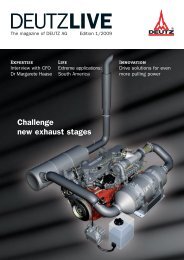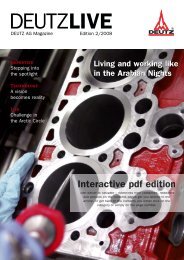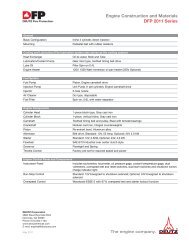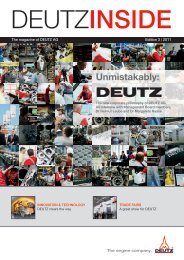New drive – Curtain up for the technology of the future - DEUTZ Home
New drive – Curtain up for the technology of the future - DEUTZ Home
New drive – Curtain up for the technology of the future - DEUTZ Home
Create successful ePaper yourself
Turn your PDF publications into a flip-book with our unique Google optimized e-Paper software.
Rubrik Life<br />
<strong>DEUTZ</strong> at <strong>the</strong> top <strong>of</strong> world<br />
Between <strong>the</strong> world’s most highly populated states, <strong>the</strong> autonomous region <strong>of</strong> Tibet’s People’s Republic <strong>of</strong> China<br />
in <strong>the</strong> north, and India in <strong>the</strong> south, west and east, is <strong>the</strong> state <strong>of</strong> Nepal, on average <strong>the</strong> world’s highest<br />
country. To <strong>the</strong> north and east lie a major section <strong>of</strong> <strong>the</strong> Himalaya range including Mount Everest, whose summit<br />
at 8,848 m above sea level is <strong>the</strong> highest point on earth, as well as seven o<strong>the</strong>r <strong>of</strong> <strong>the</strong> world’s highest peaks. In<br />
this country, whose climate poses many challenges, <strong>DEUTZ</strong> has a presence with its air-cooled engines<br />
that provide reliable local energy s<strong>up</strong>plies as diesel gensets..<br />
For <strong>the</strong> inland state <strong>of</strong> nearly 30<br />
million inhabitants, with many<br />
living in <strong>the</strong> Himalayan region,<br />
each day poses fresh challen-<br />
ges. There are more than 16<br />
hours <strong>of</strong> power cuts daily, and<br />
this in a country where more<br />
than <strong>for</strong>ty percent live above<br />
22 <strong>DEUTZ</strong>LIVE 01/2010<br />
3,000m. The majority <strong>of</strong> Nepalese,<br />
around 85%, live on <strong>the</strong><br />
land with 15% being urban dwellers.<br />
The most populated centre<br />
remains <strong>the</strong> Kathmandu valley,<br />
where nothing functions without<br />
energy s<strong>up</strong>plies. It is not<br />
just <strong>the</strong> banks and <strong>of</strong>fices that<br />
require a guaranteed s<strong>up</strong>ply <strong>of</strong><br />
energy, but also <strong>the</strong> hotel sector<br />
- Nepal is a magnet <strong>for</strong> tourists.<br />
Around 300,000 people travel<br />
to Nepal each year with tourism<br />
bringing in €50m, around 30%<br />
<strong>of</strong> total income. Temperature<br />
and air pressure represent daily<br />
challenges to humans and machines<br />
alike in a country where<br />
some regions even today remain<br />
undeveloped. The air cooled<br />
<strong>DEUTZ</strong> 914 series engines are<br />
<strong>the</strong> insider tip <strong>for</strong> this mountai-<br />
nous region. They are easy to<br />
use and extremely economical.<br />
Fur<strong>the</strong>rmore, <strong>the</strong> robust <strong>DEUTZ</strong><br />
engines can always be depen-<br />
ded on irrespective <strong>of</strong> <strong>the</strong> monsoon<br />
climate temperatures ranging<br />
between -20°C to +32°C.<br />
The engines are equipped with<br />
an extra kit that is adapted to<br />
<strong>the</strong> region in which <strong>the</strong>y are to<br />
be used. There are specific kits<br />
<strong>for</strong> desert applications, <strong>for</strong> use<br />
in artic conditions or <strong>for</strong> tropical<br />
heat and humidity conditions.<br />
The air cooled <strong>DEUTZ</strong> engines<br />
in <strong>the</strong> gensets are available in<br />
per<strong>for</strong>mance classes from 29 to<br />
152 kVA. Gensets with <strong>DEUTZ</strong><br />
engines are a real alternative in<br />
<strong>the</strong> Nepalese market because<br />
demand <strong>for</strong> energy <strong>the</strong>re is continuously<br />
growing. A s<strong>up</strong>ply grid<br />
caters <strong>for</strong> <strong>the</strong> major centres<br />
where energy is required, and<br />
hydroelectric plants feed an<br />
additional 550 megawatts into







